Matador Network's Blog, page 2317
February 14, 2014
How to piss off a vegetarian

Photo: Christian Bucad
1. Make bacon jokes, constantly.
North America is obsessed with bacon. I’m not sure where the phenomenon came from — but when I think about it hard enough, I say it’s just to piss off the vegetarians, the Muslims, and the Jews all at once. Insist on calling your morning breakfast “Babe,” make oinking noises while eating, and comment on the meal your vegetarian friend just made you by saying, “It would taste even better with bacon.”
Behind our forced smile, all we want is to tie you to a chair and force marinated seitan into your dirty mouth.
2. Pull a rabbit, a chicken, or a cow out of your sleeve.
If you used up all your bacon jokes, here’s another trick to trigger fury in your (soon-to-be-ex) friend: Make a delicious lentil curry, let the aroma spread around your kitchen to fool your prey, and when it’s finally time for everyone to sit down for supper, drop the bomb:
“You don’t mind if I used chicken broth to cook the lentils, do you?”
For added rage, act annoyed: Sigh loudly and look offended when we tell you that, yes, in fact, we do mind, because chicken broth is basically chicken juice, and vegetarians don’t eat chicken.
3. Fake it.
“I am a vegetarian too…”
Suddenly that dinner party doesn’t seem so bad anymore! We have an ally, somebody who understands that we’re not a weirdos, somebody who will support us when the aforementioned jokes come our way!
“…but I eat a bit of chicken and fish for protein.”
Now all we want to do is give you an onerous lecture on nutrition and the meaning of vegetarianism. Stop calling yourself a vegetarian and hide before your pants catch on fire.
4. Explain how much you love animals.
So the sight of a morally responsible person made you realize you’re participating in mass murder when you eat meat, and you can’t help but try to make yourself look better in our eyes.
“I love animals, you know. I have a dog and I love him. I would never kill an innocent creature. I mean, really, I would never be able to hunt anything, but I love eating meat.”
Who said cognitive dissonance was a bad thing? You certainly wouldn’t want to be dragged down into that sad plant-based pit we inhabit. But you don’t have to be, because you’re a good person who loves animals. You’re free as a bird…not the factory-farmed kind, obviously — one of the cute innocent ones.
5. Ask us what we cook at home.
Every time I go and visit my family and friends in France, I have to deal with their questions about what I cook for myself. (Note to fellow veggies: France is NOT vegetarian-friendly.)
“You don’t eat fish, right?”
“No, I don’t. Fish are animals, remember?”
“So, what do you eat at home? ‘Cause when you come over, I just lose it, it takes me forever to figure out what I’m going to cook for you.”
“Well, I make chillies, hummus, curries, soups…”
“Hmm, none of those sound very good.”
That’s right meat-eater! Make these wimps list all the dishes they make at home, reject their answers, or, even better, ask for the recipes and never use them so you can ask them the very same questions over and over for decades to come.
6. Worry for our health.
Advise us to take a blood test, mention that we do look quite pale, and furrow your brow before saying that you’re quite certain the lack of protein is slowly destroying our system. After that, sit back and watch the fireworks coming out of our ears.
7. Become a vegan.
Vegetarians are just weak vegans. We feel threatened by these super humans who’ve managed to stay away from cheese more than two days in a row. We know we can’t mess with them, because they’re the only ones next to whom we feel dietarily inferior.
So if you really want to piss off your vegetarian friend, go vegan. [image error]
The post How to piss off a vegetarian appeared first on Matador Network.

February 13, 2014
5 life traps surfers should avoid

Sure, this is beautiful. But so is the rest of your life. Photo: Matt Clark
1. Don’t let surfing rule your life.
Surfing, in the grand scheme of things, is not important. It is not something that should take away from anything else in your life. In fact, if it is done correctly, it should add to everything else in your life.
Your partner wants you to surf less and see them more? Surf less and see them more. Showing up late to work and getting your boss’s leather couch all sandy? Get up earlier, get that surf in, then get to work on time. And brush yourself off, for Christ’s sake.
A lot of surfers have a tendency to pretend surfing is more important to them than it actually is, because that’s part of the surfer stereotype: Surfing’s the source. Change your life, swear to God. Etcetera etcetera. It’s not the source. It might change your life, but probably not in some epiphany-type realization — you might just get healthier and feel a little more relaxed. And that’s not from just surfing. That’s the exercise and the vitamin D.

Don’t be this. You can’t do it better than him.
2. Don’t try to be a surfer.
Just surf. If you surf, and you love surfing, you’re a surfer. Don’t actively try and be a surfer that you’ve seen in a movie, because they’re not real. And if they were, they wouldn’t be all that great. Just be who you are, and surf while you’re doing it.
There’s almost nothing worse than talking to someone who has recently identified you as a surfer while they themselves are also a surfer. It’s not some elite club with a secret handshake and a lig patinay password. It’s just surfing, and Spicoli isn’t real — nor should he be.

Go. Photo: Patrick Eichstaedt
3. Don’t pull back.
Surfing can be scary sometimes. That’s part of the fun. But because it can be scary, it can also be very easy to back out of opportunities that may not come your way again. Remember that wave you pulled back on that you wish you didn’t? Everyone has a few of those.
Don’t pull back. Unless you’re surfing massive Teahupoo, chances are good that you won’t die. Sure, you might get a little hurt, but that will heal. And if you make it, that memory will be a whole lot better than kicking yourself for the rest of your life.

This is really, really unlikely to happen at your local spot. Deal with it. Photo: Roche
4. Stop chasing perfection.
While surfing (ideally) is great for being in the moment, it’s also incredibly easy to think about why it’s not as good as it could be. Yeah, the wind is a little onshore. And yes, the direction is a bit off. But it doesn’t matter, really. Being too focused on a destination can ruin your whole trip. There are a million clichés around that, and they’re all true.
Enjoy the wave you’re on, don’t hate it for being too small. Try not to think about how much better it was the last time you were here, or during that perfect swell last fall. Enjoy the moments of greatness, but realize they are few and far between. After all, that’s what makes them great.

This is the only man that’s allowed to be looking back. Focus on what you’re seeing, not what you want someone else to see.
5. Avoid social media.
Social media is our culture’s most narcissistic creation. Everyone is posting things they want others to see, but no one cares, because they’re all just posting things they want others to see. It’s an awful little circle. In the age of GoPros, Facebook, and Instagram, showing what you’ve done to the faceless masses is easier now than it has ever been before.
But when you’re concentrating on capturing the moment for someone else to see, you miss out on it yourself. And don’t forget: No one actually cares how much you pretended to enjoy yourself, so you might as well actually enjoy yourself. What a novel concept! [image error]
* This post was originally published at The Inertia and is reprinted here with permission.
The post 5 life traps surfers should avoid appeared first on Matador Network.

How China treats Internet addicts
IN 2008 China added internet addiction to its list of clinical disorders. This is a facility where addicts are confined and made to perform military-like drills and attend therapy sessions for periods of 3-4 months. Parents are encouraged to stay and take part.
When I first started watching this I thought I was going to hate it. I immediately assumed this was going to be some investigative report highlighting another of China’s human rights abuses. Now, I know seven minutes isn’t giving me the whole story, but if what I saw here is representative of what’s happening I can understand why this exists. An addiction is an addiction; just because the internet isn’t a substance you consume like drugs or alcohol or food doesn’t make it any less addictive.
I was glad to see the talk being given to the parents; it wasn’t being given in any kind of blaming way. It’s a somewhat progressive stance, even empathetic towards the patients, pointing out the root cause of the addiction and hopefully educating the parents. One thing that’s missing from this report from the New York Times, though, is any result from this method of treatment. Does it actually work? 
The post This is how China treats its internet addicts, and it’s not what you think appeared first on Matador Network.

Your stomach will drop after watching how high these skywalkers climb
AT JUST OVER 2132 feet, the Shanghai Tower in China is the second tallest building in the world. These skywalkers take extreme climbing to a whole other level. Try not to let the GoPro-head-cam angle get to you — the views these guys picked up along the way are beyond epic.
For more jaw (and stomach) dropping images, check out this article on Urban free climbing. 
The post Your stomach will drop after watching how high these skywalkers climb appeared first on Matador Network.

8 things NOT to do in the Southwest
I once worked in Aradia, an indie bookstore in Flagstaff during the decade of “Oooooooo, the romantic Southwest…let’s build a great big house here and find peace.” One noon, a woman burst through the door. She had large hair, a spotless white Stetson, and hand-painted pink Tony Lamas. “You’ve got to help me,” she gasped. I started to call 911. She held up her hand. “I broke my fingernail! I need a nail salon — close by and right NOW! Do you even have nail salons in this place?”

Photo: moominsean
I debated sending her in the wrong direction, but there was something about her desperation that stopped me.
“Okay,” I said, “I know a place with a nail aesthetician (I’d always hoped I’d have a chance to use that word in normal conversation). Chez Chi Chi. Shall I give them a call?”
“Oh thank god,” the woman said. Two minutes later, she had a walk-in appointment. Her husband, a standard issue silver-haired guy in golf shirt, shorts, sandals, and socks, came in and rolled his eyes at me and they were gone.
Here’s a brief guide to how not to put yourself in their company. Pay attention. While we might not ride you out of town on a rail, we will give you the stankeye — and wrong directions.
1. Don’t…
eat in chain restaurants and complain about how the food all tastes the same.
Do…
take yourself to Los Altenos in the Sherwood Forest mall on Milton and dive into a huge bowl of caldo de pollo with a side of jalapenos, cilantro, and rice.
2. Don’t…
ask us for directions and keep talking on your cell while we answer.
Do…
listen when we tell you what you need to know. You might even smile, and even wilder, say, “Thank you.”
3. Don’t…
act amazed when we tell you we have nail salons and internet cafes and our own theater company.
Do…
leave your urban prejudices back in the big city and learn that bigger isn’t better.
4. Don’t…
take pictures of us locals without asking. The Native Americans hate it — and really, we’re all just living, working, shopping, and hanging out in our home.
Do…
get out of your motel and your routine. Go out to Sunset Crater/Wupatki or Buffalo Park or Fat Man’s Trail. Leave your camera in the car — it’ll be safe — and use your legs, eyes, and ears to take in what is unique to our home.
5. Don’t…
wander our downtown with that look of: Gee, honey, we already saw all this in Durango, Moab, and what was the name of that other cute little town.
Do…
Go into the local shops, galleries, bars, and restaurants. And, when you eat or drink here, tip at least 20%. Flagstaff is an expensive place to live. Most of the service workers live here because they love the mountains, the canyons, the deserts, and wild places.
6. Don’t…
wear your brand-new cowboy hat and boots.
Do…
read up on the gentrification of the real West. If you want to meet a real cowboy, try to visit a working family small ranch. The folks will tell you they are too busy trying to make a living to give tours.
7. Don’t…
get suckered in by the local ski resort — either to ski or ride their lifts up the mountain in the summer.
Do…
stop in at Winter Sun Trading Post on San Francisco Street and ask the staff about the tribal anger and sorrow over the ski resort making fake snow with reclaimed water on the sacred mountains. They’ll fill you in — and educate you about the genuine handmade jewelry, Zuni fetishes, Katsina, dolls and Navajo weaving in the shop.
8. Don’t…
plan to spend one day here and kid yourself that you’ve had a real “Western” experience.
Do…
take the time to talk with the locals and learn the true beauty and value of our town and our region. That way you won’t end up on a dead-end dirt road near the landfill wondering why somebody gave you the wrong directions. [image error]
The post How not to get laughed out of a Southwestern tourist town appeared first on Matador Network.

Why 'Hostel' is the stupidest movie

Photo: Way Too Indie
“OMG dude, haven’t you seen Hostel? Aren’t you scared you’re going to get kidnapped and killed in the middle of the night like all those film actors in that one fictional movie?”
No, I am not afraid of my hostel owner gutting me with a knife in my sleep, and nor should you be. Because travel is safe, you ask? Nay. Travel is not always safe. But that is due to a rather flagrantly obvious and deviously simple truth: Life isn’t safe.
Nothing ever is. Risks are all around us, and there’s no telling when you might just trip over a condom wrapper left in the street and smash your face against a telephone pole and splatter your brains all over the pavement some idiot used as an impromptu toilet the evening immediately prior.
But let me tell you something: A hostel is the absolute safest place a backpacker can possibly find him or herself whilst imbibing the alcoholic and experiential gifts a foreign land can bestow. Allow me to explain why…
A hostel is filled with an army of youthful citizens at the peak of the physical capability.
In few other circumstances can a victimized young target of violence be more readily defended than in a 42-bed dorm room populated by boundlessly muscular, heavily intoxicated young gentlemen whose current physique stands at the uppermost echelon of what they will ever achieve in their lifetime. And with impossibly indigestible quantities of alcoholic substances coursing through their veins, their diminished ability to process the sensation of physical pain will render them nearly impervious to the danger posed by any assailant wielding a melee weapon of any kind.
Of the utmost importance in this particular case, however, is the insatiable desire to defend the livelihood of helpless young ladies anywhere to be found, in a perhaps misguided, though entirely appreciated attempt to obtain the endorsement of their reproductive quality control guidelines in the aims of potentially engaging in post-traumatic reproductive recreational activities shortly following the incident of horrific danger.
They will be there for you. And they will win.
Someone’s always awake.
Seriously, have you even been in a hostel? It is a chaotic inferno of constantly coming, going, talking, drinking, shouting, zipping and unzipping, buckling and unbuckling, and crinkling of crinkly clothing into which no self-respecting Psycho enthusiast would dare attempt wade.
And even in the unlikely event that 100% of hostel dorm room occupants are simultaneously unconscious, even Usain Bolt would find it a daunting challenge to speedily make his way from one bed to the next, climbing atop loudly creaking bunk beds one after another, thus slowing his progress and rendering the task unlikely to be completed by the time half a dozen strapping young gentlemen awake from their slumber.
For a description of the aftermath that would ensue, refer back to objection #1.
He won’t be able to collect your bill.
…and your 85-liter pack full of soiled clothing is the last thing you’ll find on his holiday wishlist, below elephant feces and Betamax devices.
What of your laptop, you say? He’s probably got one already anyway, and it would be a rather not-lucrative business to lose out on the cash he’d get from the bill you owe just to sell a deteriorating machine of diminishing value which you might not even have anyway. Plus, who’s going to give him a 5-star review on Hostelworld? Not you!
Can you imagine the hassle of removing a body from a hostel dorm room, not to mention the already-irritating hassle of having killed someone, silently enough that no one notices, paying for its disposal, and then selling a cheap laptop on the open market on a regular basis, all the while losing out on a continuous stream of hostel-dwelling bill-payers whose only significant upkeep consists of ongoing sheet laundering? Seems to me like this guy is an incompetent businessman, and if such is the case, he’s probably an incompetent serial killer, too. So no worries.
Here are some movie titles more appropriate than “Hostel.”
You know what that movie should have been called? Hotel. Think about it. What does a hotel have that a hostel doesn’t?
Seclusion: You’re all alone in that eerily quiet room of yours, with no one to defend your defenseless little body.
Locks: What the hell good is a hostel door going to do when an easily lockable hotel door will keep other suspicious guests from making a timely entrance?
Cold, uncaring guests: Have you ever broken down the door of a hotel room to defend a fellow guest against the murderous hand of a homicidal hotelier? No, I didn’t think so. You’d probably tell yourself the guy in the other room is just watching a scary movie anyway. Like Hostel.
They could have just called the damn thing Bed and Breakfast and it would have made a whole lot more sense. Who would ever suspect the innocent and charming elderly lady running a precious and adorable little B&B on the edge of a small town? No one, that’s who. And it’s always the people you least suspect that you’ve got to watch out for. [image error]
This post was originally published at Snarky Nomad and is reprinted here with permission.
The post Why Hostel is the stupidest travel movie of all time appeared first on Matador Network.

57 fascinating maps of our world
THERE’S SO MUCH MORE to the world than we can usually glean from a map of a place.
Sure, you’ve got the political and topographical maps we’re all familiar with, and from those we can see the boundaries we’ve created and those that were naturally imposed…but what about burning questions like, “How does my country rate on the global attractiveness scale,” or “Where are all the redheads of the world hiding?”
Thanks to the wealth of data floating around for free use on the internet, with these maps we visual learners can finally get a better sense of the global scheme of things, and perhaps find answers to several questions we never even thought of asking.

1
Map of the world according to Americans
From his international bestseller “Atlas of Prejudice,” this is Alphadesigner Yanko Tsvetkov’s impression of the world from the perspective of Americans.
(via)
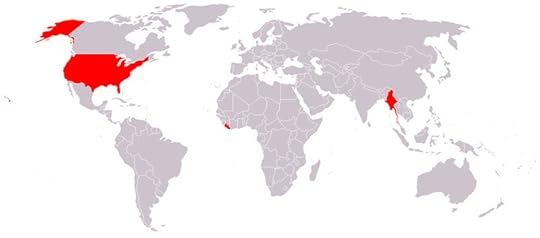
2
Countries that don't use the metric system
In our American punk-rock refusal to conform, we find ourselves in the minority, as nearly the entire world uses a system of measurement that makes base-ten sense. Those other countries representing the Imperial system are Liberia and Myanmar (Burma).
(via)

3
US map of the highest-paid public employees by state
After seeing this, my first reaction was, “Perhaps I’m in the wrong profession,” followed shortly by, “Clearly, America loves its football.” It does, it loves its football $5,545,852.00 much (Head Coach Nick Saban of Alabama’s 2013 salary).
(via)
Intermission

Yelp Worldmap: What’s the hipster density in your city?
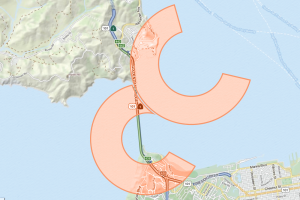
20 maps that will change the way you see the world

Four maps that make the world more awesome
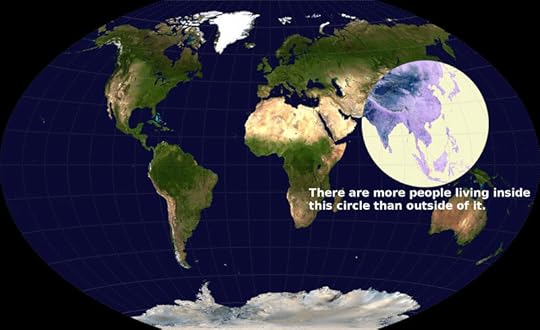
4
Perspectival take on global population density
With more than 2/3 of the population of the entire United States crammed onto the islands of the comparatively tiny Indonesia, this map throws into sharp relief just how much of the planet seems to be relatively uninhabitable (or, at least, nowhere near as densely packed). As an aside, the ongoing discussion over this map has yielded that the circle could in fact be considerably smaller than shown.
(via)

5
Political map as Pangaea
Pangaea was a supercontinent that existed for about 100 million years before fracturing apart 200 million years ago and moving slowly into the current continental configuration. This is what the world would look like had that land mass stayed intact.
(via)
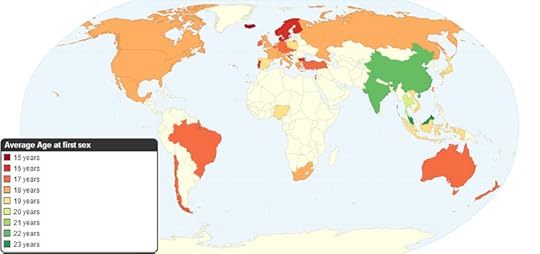
6
Average age of first sexual intercourse by country
A shining example of something to do “just because we had the data,” this map of average deflowering ages around the world arrives also as relatively unsurprising. I say relatively, because apparently in Iceland the young’uns are doing the deed at the barely ripe average age of 15. Until 2007, the legal age of consent in Iceland was 14, but was then revised to the current age of 15 to more closely match Norway and Finland, where it's 16.
(via)

7
World map of paid maternal leave
The sad and maddening truth is that the US, somehow ever the minority, is one of eight countries without mandatory paid maternity leave. Those other 7 countries listed are: Suriname, Liberia, Palau, Papau New Guinea, Nauru, Western Samoa, and Tonga.
(via)

8
Map of time zones in Antarctica
This gem demonstrates that all time zones of the world must converge, and happen to do so longitudinally on Antarctica. However, UTC or Coordinated Universal Time refers to “no time zone,” so those areas in red are actually sort of a generic “Antarctica Time.”
(via)

9
World air travel routes
This map, which includes only the arcs made in air travel routes, demonstrates the beautiful world-connectedness that flight has enabled.
(via)
Intermission
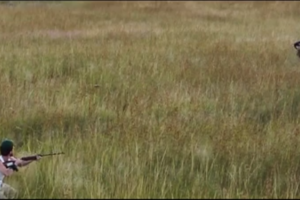
What Hollywood flicks about Africa are really saying

Here’s what riding on the first commercial spaceship will be like

This 5-year-old knows more about the world than you do

10
Africa, as made up of other countries
Based on our current accepted map projection formats, countries either at the equator or at the edges invariably get distorted in size. Here’s a map of Africa, with a number of random countries superimposed over it to get a relative feel for the size of the continent.
(via)

11
Map of alcohol consumption around the world
Perhaps growing up in Las Vegas put beer-goggles on my sense of America’s global standings on alcohol consumption. Still, that dark purple mass indicating a greater-than-12.50 liter per-capita consumption of pure alcohol must mean the Russian liver is a force to be reckoned with, especially considering your standard vodka is only 40-50%.
(via)

12
Map of alcoholic beverage of choice by country
When juxtaposed with the previous map, one thing becomes strikingly clear: The volume of notoriously low-alcohol-content drinks (beer and wine) that is clearly pounded in Europe to allow them to rank so highly in pure alcohol consumed must be staggering (no pun intended).
(via)
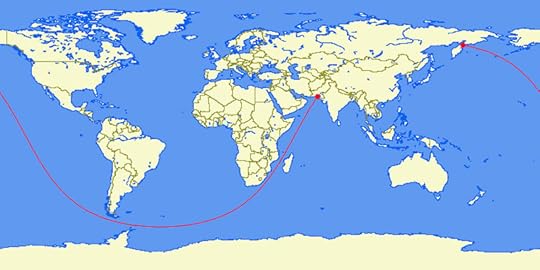
13
The journey (almost) around the world
Pictured here is the longest straight line that can be sailed on Earth. The 20,000-mile journey stretches from Pakistan to the Kamchatka Peninsula (in Russia). With the average sailing speed of about 7.5 knots, this trip would take almost 20 years to complete.
(via)

14
World map of earthquakes since 1898
This is what happens when you plot over a century of earthquake data, with the magnitude of the earthquakes dictating the brightness of the coloration on the map—you get an incredible image of Earth’s tectonic plate boundaries in glowing relief. Fun fact: 1898 was also the year Tesla claimed to have unveiled a version of his oscillator that caused an earthquake in New York, later earning the device the nickname “Tesla’s earthquake machine.”
(via)

15
Freedom of press map
From 2012, this map outlines the relative freedoms of press per country of the world. In essence, if you’re living in China, Vietnam, Laos, Burma, Uzbekistan, Turkmenistan, Iran, Syria, Azerbaijan, Belarus, Yemen, Sudan, Eritrea, or Somalia, you’re probably not vying to be a hard-hitting journalist.
(via)
Intermission
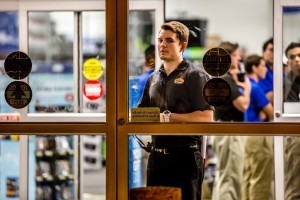
How people around the world feel about Black Friday

What do your country’s trending hashtags say about you?
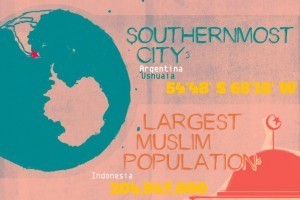
20 trivia facts about world countries [Infographic]
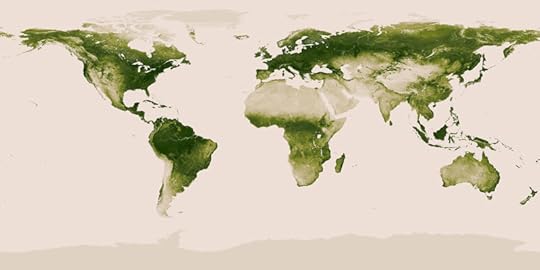
16
Map of vegetation on Earth
Courtesy of NASA, the National Oceanic and Atmospheric Administration, and the Suomi National Polar-Partnership satellite, we have this snapshot as a gentle reminder that there is still quite a lot of green life on this planet, and we should do everything we can to preserve that.
(via)

17
Inverted population of Australia
This map flipped the paradigm, as the shaded region represents where only 2% of the entire population of Australia lives, meaning the un-shaded region is home to 98% of Australia’s population.
(via)

18
Cramming the world’s population into one city, by density
Superimposed over the United States, this map demonstrates how large the single city would be if the entire world’s population lived in it, based on current city densities from around the world. The missing piece of this puzzle is the fact that the current population density for Paris is approximately 54,899 people per square mile of the 40.7 square miles of the city. With Manila’s 111,002 people per square mile in the Philippines, the world’s population would fit in a city the size of Washington State (with plenty of wiggle room).
(via)

19
World lightning strike frequency
At first glance, this map, and the information contained therein, seems underwhelming. Until, of course, you notice that there is an area on the border of what appears to be Zaire and Tanzania that averages ~200 lightning strikes per square kilometer per year.
(via)

20
World map of researchers per million inhabitants
Aka “Most Science Oriented Places on Earth,” this map shows the prevalence of individuals choosing lab-life as a career path. Taken with the “Average age of devirgination” map from earlier, there seems to be a strange correlation between regions with younger kids having sex, and those with higher rates of researchers per capita.
(via)

21
Most famous US brands, by state
America is pretty obsessed with branding, and of the multitude of brands spawning from each state, here is the spread of the most famous.
(via)

22
Writing systems of the world
This elegant summary of the distribution of the world’s various writing systems not only demonstrates which areas write in what, but also just how many globally in-use writing systems there actually are. It’s fascinating to think that a person from any of those other regions would see this map in much the same way I do, that there is one area they can read and a multitude of what appears to be gibberish.
(via)

23
Worldwide annual coffee consumption per capita
In kilograms per person per year, this map outlines the major joe-junkies of the world. I was surprised to see that Canada out-caffeinated the US. After the other maps, I was not surprised to see that Iceland, Norway, and Sweden out-coffee’d the world. There are some strange things going on under those Northern Lights.
(via)
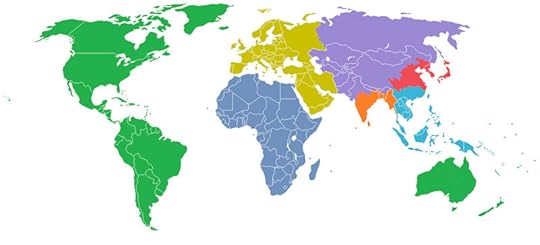
24
The world divided by population
Color-coded into 7 regions, each with a total population of 1 billion, this map is another great example of visualizing the global population density and distribution. It also seems to corroborate the circle-map from earlier.
(via)

25
World population by latitude and longitude
Yet another take on the visualization of the global population distribution, this map-pair demonstrates the desirability and inhabitability of the tropics, with their major intersection hovering over the Indonesia/Philippines region.
(via)
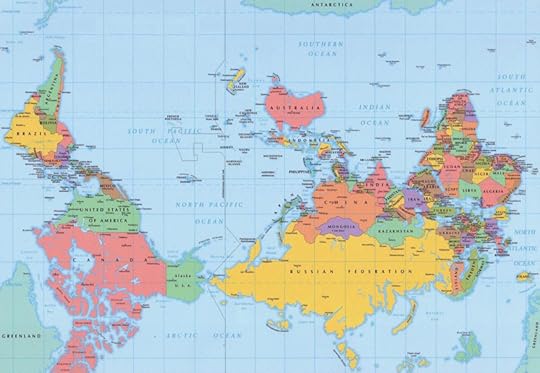
26
South-north world map
Breaking from the long-held convention of orienting north as “up” established by Ptolemy (90-168 AD), and resulting from the majority of cartography taking place in the Northern Hemisphere, this world map seems turned on its head (by orienting south as up). Fun fact: Evidently in the Middle Ages, cartographers routinely fixed east as up, “to orient.”
(via)

27
Topographic map of the United States on the moon
Wrapping almost two-thirds around the moon, this image puts into sharp perspective the size of the US, the size of the moon, and, indirectly, the size of Earth.
(via)

28
Global internet usage based on time of day
With that orange upside-down “U” representing daylight hours, and a color spectrum spanning from red to blue (red indicating usage increase above average, blue indicating a usage decrease), this gif-map is visually stunning, but perhaps not terribly surprising.
(via)

29
Global overall water risk
Another map for the environmentally conscious, this representation demonstrates a near-perfect strip between latitudes around the globe in which water seems to be in scarce supply, and draws attention to the fact that Earth is covered in water that we simply can’t drink.
(via)
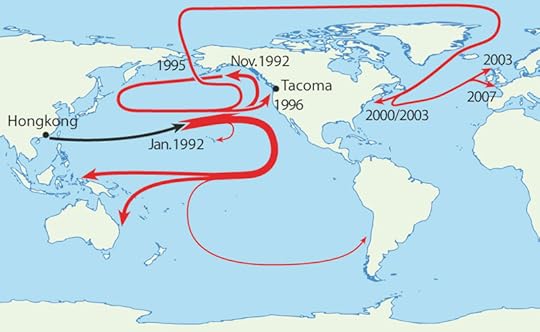
30
Map of the duckies’ journey
Do you remember hearing about some 29,000 rubber duckies that fell off a cargo ship coming out of Hong Kong? Here’s a map of the routes those duckies took, and the various places they made landfall over the 15 years they were at sea (from 1992 to 2007).
(via)

31
Mercator world map with a different centerpoint and orientation
Another map that seems to challenge convention and distort the planet, this west-up Mercator projection (the cylindrical style world maps invented by Gerardus Mercator in 1569 and possibly the most common type of map ever) centered on Greenland instead of Europe is no more or less accurate than the world maps you’re used to seeing.
(via)

32
Map of US GDP compared to the rest of the world
This map compares the GDP of US states to entire countries from around the world, ranging from $1 trillion (such as California/Canada).
(via)
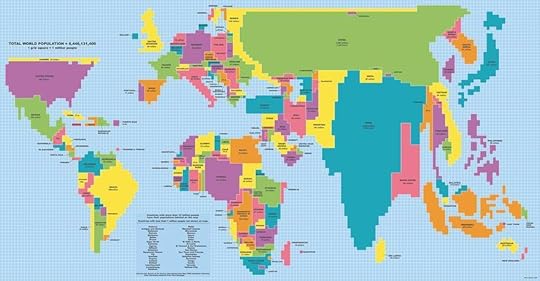
33
World map of population proportions
For the mathematically inclined, this map has restructured the world’s countries to accurately represent their population as opposed to confining it to landmasses, and demonstrates just how much of the world’s population lives in India. One grid square equals one million people.
(via)

34
World map of social networks
From time one (2009) to time two (2012), one thing is absolutely certain: Facebook is taking over the planet.
(via)

35
Mapped: US in seven deadly sins
While I don’t wholly agree with the criteria used to compose each sin-map, it was interesting to see the distribution of average income compared to the poverty line, total theft, number of violent crimes, entertainment expenditures, fast-food restaurants, number of STD cases, and an aggregate of the lot in a plain and clear representation. It would seem that Iowa is the most “saintly” by these standards.
(via)
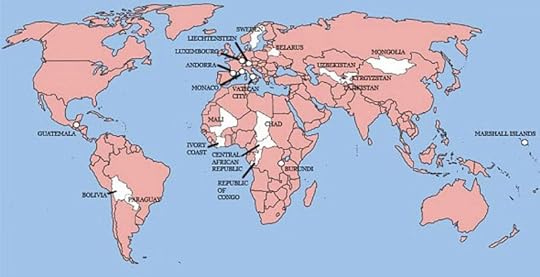
36
World map of countries England has not invaded
Of the 196 countries of the world today, there are only 22 of them that Britain has not invaded, though only 21 appear on this map (suspiciously absent is the island nation of Sao Tome and Principe).
(via)

37
US auto-complete map
With the recent success of “crowdsourcing” for everything from ideas, to products, to scientific data, it would be difficult to deny there must be some horrifying truth to the information in this map. Populated by searching “State name is…” in Yahoo and allowing the “topmost satisfactory result” to represent each state, this map illustrates exactly what the internet seems to think about the states, and the US as a whole.
(via)

38
Map of European attractiveness
Sure the sample size may be small, but it seems the overwhelming majority of people involved in the data-collection of this map strongly believe Sweden is where it’s at when it comes to attractive people.
(via)
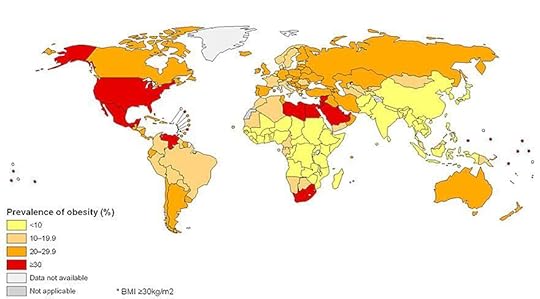
39
Global prevalence of obesity
While the “fat American” image seems to be echoed with some truth in this map, somehow Mexico, Venezuela, Libya, Egypt, Saudi Arabia, and South Africa missed that update to their respective stereotypes.
(via)

40
World driving orientation
Though I wish this were subdivided by regions into “left side of car” and “right side of car” appearance of steering wheels, this map demonstrates which side of the road people drive on, a completely different and equally nerve-wracking experience to the simple migration of the steering wheel to the other side of the car.
(via)

41
Inverted land/ocean map
While not a real map in the sense that it doesn’t depict reality, this interesting shift illustrates what the world would look like if land was ocean and ocean was land.
(via)

42
Different names for beer in European languages
An absolute must-memorize for any Europe-bound traveler, this map outlines the major types and names for beer in the various languages around Europe.
(via)

43
World map of country flags
This almost painfully colorful map shows the world’s countries with their respective flags superimposed over the land. Here is a breakdown of every national flag, and the relative proportion of each color in the flag on a pie chart.
(via)

44
World map of national IQ scores
Though Intelligence Quotient scores tend to only to be indicative or even suggestive of learning ability, and must always be taken with a grain of salt, this map proves interesting in the distribution of world IQ, and begs for a redefinition of “average” intelligence (particularly in the spread of light green). Again, Norway and Iceland stand to be recognized as outliers, though this time Italy, the UK, China, Mongolia, South Korea, and Japan join their ranks.
(via)

45
Most famous popular musicians, by state
Sourced from Acclaimed Music, this distribution of “most acclaimed” popular musician from each state is like a history and pop music lesson all at once.
(via)

46
World welcome map
Another must-see for the world traveler when planning a trip, this map compares the relative welcome-ness of countries to foreign visitors, with blues indicating “more welcome” and reds indicating “less welcome.”
(via)
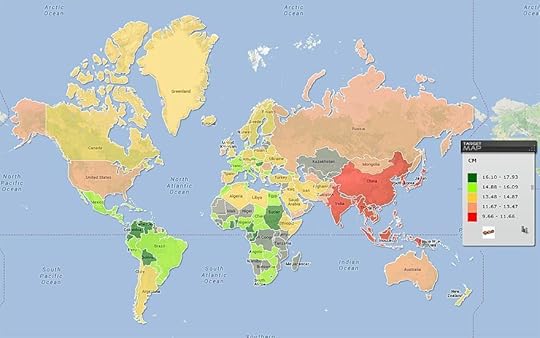
47
Penis size world map
Outlining the average penis size for the country in centimeters, this map alone serves as an interesting look at your fit in the global scheme, and an unfortunate statistical reinforcement for genitalia-related stereotypes. This map would be most interesting, however, when compared to a map of the distribution of the world’s nuclear weapons.
(via)
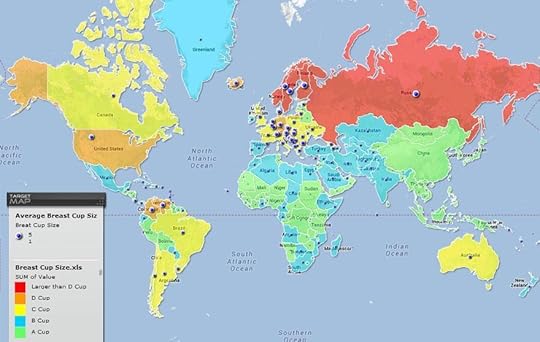
48
Breast size world map
The trend in this map are the coloration of the countries by average breast cup size, ranging from green (A cup) to red (larger than D cup). Interestingly, there’s almost no discernable global trend I can find between breast size and penis size.
(via)

49
World web browser map
Though perhaps unsurprising, there seems to be an about-equal distribution of national pride for Internet Explorer, Firefox, and Google Chrome in 2012. Representing Opera, however, Belarus stands alone.
(via)

50
World map of most popular sports
America still loves its American football, but it seems the rest of the world generally prefers…football. The other major popular sports include: table tennis (purple), ice hockey (bright blue), cricket (bright red), wrestling (off-white), baseball (yellow), and basketball (orange).
(via)

51
Europe's distribution of redheads
Perhaps rather obviously, it seems Ireland is the epicenter of red-headedness in Europe. What is surprising is the intense concentration of redheads in western Russia, somewhere north of Kirov, though my research did not return much as to why there might be such a colony.
(via)
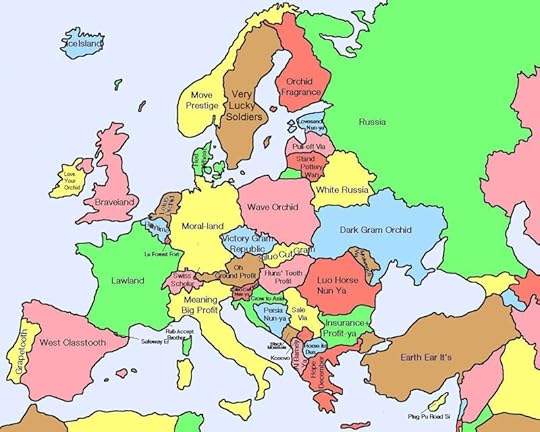
52
The Chinese map of Europe
This one takes a bit of explaining. Here is a map of Europe, based on the phonetic translations from country-names in Chinese to English. So, each country has a name in Chinese that sounds like how it's pronounced in its native language, but the Chinese characters used to create that pronunciation have literal meanings different from their sounds. These are those literal meanings.
(via)

53
US House of Representatives, by religion
This outline of the major religions represented by the 435 members of the US House of Representatives includes: Anglican/Episcopalian, Baptist, Buddhist, Catholic, Hindu, Jewish, Lutheran, Methodist, Mormon, Muslim, Other Christian, Presbyterian, Uniterian, and Unspecified/None. As a US citizen, there are honestly twice as many religions on that list than I expected, which is probably telling in and of itself.
(via)

54
Most popular surnames in Europe, by country
While pretty self-explanatory, this collection of by-country most-common last names shows that European countries represent at least two of the 10 most-common surnames in the world (those names are: Garcia, Wang, Zhang, Li, Smith, Müller, Gonzalez, Smirnov, Nguyen, and Hernandez).
(via)

55
Most popular surnames in the US, by region
Broken up by regions, this map denotes the most popular surnames in the country, where size of print indicates portion of population with that surname, and color indicates origin of that surname. Almost all 10 of the world’s most popular surnames can be found (again, those names are: Garcia, Wang, Zhang, Li, Smith, Müller, Gonzalez, Smirnov, Nguyen, and Hernandez).
(via)

56
Earth in reverse
It’s upside-down, backwards, the land and sea have been inverted, and the elevations and depths have been swapped. This is what the world would look like completely inverted.
(via)

57
Area codes of Luda's "hoes"
I simply couldn’t resist. From Ludacris’ 2001 hit single “Area Codes,” this map chronicles every telephone area code in the United States where Ludacris claims to have had sexual relations with women. Those area codes are (by order of appearance): 770, 404, 718, 202, 901, 305, 312, 313, 215, 803, 757, 410, 504, 972, 713, 314, 201, 212, 213, 916, 415, 704, 206, 808, 216, 702, 414, 317, 214, 281, 334, 205, 318, 601, 203, 804, 402, 301, 904, 407, 850, 708, and 502. From his legendary conquests, some 0.5% of the entire world’s population has descended from Ghengis Khan, so it looks like Ludacris has some catching up to do.
(via)
The post 57 maps that will challenge what you thought you knew about the world appeared first on Matador Network.

Preaching the gospel on Michael Sam
WHEN MICHAEL SAM, an All-American defensive end for the University of Missouri Tigers, came out as gay during an interview with ESPN last week, it sparked a lot of excitement that the NFL is in line to get its first active openly gay player. Sam is finishing up his senior year at Missouri and is considered a third- to fourth-round pick in the upcoming draft.
Apparently, though, not everyone is sharing in that excitement. Certain “anonymous NFL executives” have predicted Sam’s draft chances will worsen as a result of his revelation.
Dale Hansen, sportscaster for Dallas’s WFAA, has something to say about that. And we should all listen. 
The post Dallas sports anchor preaches the gospel on future NFL trailblazer Michael Sam appeared first on Matador Network.

Travel writing tips: Become a camera

Photo Credit: kevin dooley via Compfight cc
The travel writing tips below are excerpted from new lessons at the MatadorU Writing course.
WE MOST COMMONLY describe place through our eyes. In some ways we can think of a narrator almost like a camera.
One thing to keep in mind however, is not to “get in the way” of the camera too often. Take this example:
I looked out over the vast playa as the sun was setting.
Notice how the narrator (“I”) is “in the shot.”
When we remove the narrator from the shot so it’s just a description of the terrain, the visuals tend to come out more direct and vivid:
The sun was setting over the vast playa.
As writers, we “get in the way” simply because we’re unconsciously stating what we saw, for example:
I saw taxis speeding down Avenida de Mayo.
But by not being super-conscious of exactly how each word affects the reader’s experience of the story, we may inadvertently “clog” the composition. Note how the unclogged version reads more crisply:
The taxis sped down Avenida de Mayo.
Sometimes this extra layer inserting yourself as narrator into the action (ex: “I saw”) is important however, especially if it allows you to reveal something about changing emotions or moments of new awareness. But again, this should be a conscious decision on how you’re trying to shape the narrative.
It’s also important to note that this sense of being a “camera” isn’t limited only to what the narrator “sees” but how he or she interacts in the story overall:
I climbed stairs zig-zagging upwards past dimly lit bars until I came to the top level of Sky Garden. I leaned against the bar and watched sun-bleached Australians dance with drinks in their hands to LMFAO’s Party Rock Anthem.
Notice that if we remove the self-referential parts it allows the reader to “inhabit” the narrative in a much more direct way:
The stairs zig-zagged upwards past dimly lit bars until the top level of Sky Garden, where sun-bleached Australians danced to LMFAO’s Party Rock Anthem.
How do your achieve a balance of “acting” vs. “narrating” in your storytelling?
To learn more about our programs in Travel Writing, Photography, and Filmmaking visit MatadorU.com.
The post Travel writing tips: Transforming your narrator into a “camera” appeared first on Matador Network.

Conversation with an almost-Olympian

All photos: Andy Cunningham
With the Sochi Winter Olympic Games now in full swing, we’re all becoming familiar with the names of the competing athletes. Deservedly so, as every athlete there has worked incredibly hard and each has an incredible story. But in sport, as in life and travel, much more is learned from the journey than the final destination.
Someone much wiser than myself once told me that dreams don’t mean shit unless you chase them down. If the dreamer is unwavering in their pursuit through the trials and tribulations, the highs and lows, the rejection, the frustration and heartbreak, and refuses to give up when the world is stacked against them, the dreamer becomes worthy of their dream. Ask anyone who has chased his or her dreams down, and the common thread will always be perseverance.
Life rarely works out the way you think it will. Nick Hanscom knows this age-old truth better than most. I first met Nick in the summer of 1997 on a soccer field in his newly adopted hometown of Sun Valley, Idaho. From the very beginning, it was obvious this skinny kid from Seattle had the kind of rare athletic talent that makes everyone around them appear to be in slow motion — the only problem was he knew it and was as cocky as he was talented. Like so many teenage boys, Nick had always dreamed of becoming a professional athlete, and from the way he mastered any sport he tried, it seemed like a foregone conclusion — especially to him. Sun Valley is a skier’s town, renowned for putting its native sons and daughters on the US Ski Team, so it was a natural progression for him to compete and excel on snow. His rise through the junior ranks was nothing short of meteoric.
“I started skiing bumps when I was 13 and by the time I was 16 I won the 2001 Jr. Olympics in Dual Moguls at Big Mountain, Montana, and tied for 9th in Duals at US National Championships in Waterville, NH. I won Jr. Olympics Dual Moguls again in 2002 at Sugarloaf, ME and followed that up the next week with a 5th-place finish in Duals in Finland at the 2002 Jr. World Championships. In 2003, I took 2nd at Jr. Olympics in Single Moguls at Steamboat, CO and then a 6th-place finish in Duals at Jr. World Championships in Newfoundland, Canada.
In a just a few years, I had become one of the best junior freestyle skiers in not only the country but the world. By the time I finished the 2002-03 season, I had already forgone a year of college and was thinking that at my current pace I would never have to go because I would make it so big in skiing…”
Partying his way through the off-season while flunking out of school at USD, he showed up to the US team selections in Park City out of shape and unmotivated, yet still managed a respectable showing due mainly to his incredible talent, a talent he was convinced was enough to take him to the top. The world had other ideas.
While skiing at home over Christmas, Nick’s ski tip hooked a rock and sent him cartwheeling towards the trees at over 60 miles an hour. Miraculously he didn’t end up paralyzed, but he did do significant damage to his shoulder, neck, and back. For the first time in his life, the impenetrable confidence that had so defined him was shattered. At the time, he shrugged it off and killed the nagging doubts with booze.
“I was off my feet for about a month and was probably sober for 5 minutes of that time. I finally got out of the sling and went to compete at a big Nor-Am event after doing nothing but drinking. I thought I could wing it off of my natural ability, and I was quickly humbled. That Nor-Am tour, all of my shenanigans caught up to me. I was skiing like shit, I couldn’t finish a run, and by the time the season ended I had no confidence left in myself.”
Nick, who had coasted for so long on his incredible talent and confidence, began a downward spiral into depression and self-medication that is the graveyard for so many big dreams. As Nick slipped deeper into the rabbit hole of alcohol and depression, he watched those closest to him succeed.
“All of my friends surpassed me and made the US Ski team and went on to be top 10 world ranked skiers and Olympians. I was happy for them, but it also made me feel worse about myself. No matter what I did, I couldn’t make anything work in life or in skiing. Skiing had become my entire life, I didn’t have anything else, so when skiing tanked my life tanked. I was a failure in school and now I was a failure at skiing. My ski friends were now on the US Team and my other friends were almost done with college and looking at going to law school and med school…starting their lives.
My family, who are all extremely educated, looked at me disdainfully, as I had barely any school done, and I wasn’t on the US Team, so they were like what the fuck are you doing?? And I was beginning to wonder the same thing. I would show up to training still drunk from the night before, go puke in the woods real quick and then rip a mogul run. I remember feeling like such a failure that I no longer had respect for myself and I doubt others had respect for me. I dealt with all of these negative feelings by partying a lot and burying them under gallons of booze.”
The years drifted by, and Nick’s name became synonymous with squandered talent. Just another golden child who thought it would all come so easy, and when it didn’t he dove into the numbing comfort of booze and a façade of not giving a shit. It’s a common enough story and one that rarely ends well. At the best it’s a life of regret, of should’ve / would’ve / could’ve and endless glory-days yarns spun from a bar stool. At worst it ends in tragedy, evidenced by the recent suicide of US Ski Team Aerialist and Olympian Jared ‘Speedy’ Peterson. Vowing that this would not be his fate, Nick went back to school and the gym to begin the hard work of resurrecting his talent with effort.
“The positivity coming from doing well in school and being in the gym again translated into my skiing. I began to feel confident about myself again, and at the 2007-08 US Ski Team Selections I won on one of the days. I was the only person to ever go from qualifying in 16th to winning. Unfortunately, on the other day I was in 3rd place after qualifying, and in finals I hooked an edge and missed the podium. It was a grand prix event which combines the results from the two days of competition. If had made the podium on that other day I would’ve made the US Ski Team…
I stayed positive, and the momentum carried into a great season for me. I was ranked 6th in the country, and at the 2008 US Nationals in Deer Valley I just needed to put down my run a couple of times to have a strong chance of either winning National Championships or staying in the top 7 on the points list, which would solidify a spot on the US Team for the next season. After so much doubt and struggle — all of the shit I had gone through over the past few years — the US Team was finally in my grasp once again. My dream was only a couple hours away.”
Very little in life tastes better than redemption, for very rarely are we given second chances in life — but sister fate had other plans for Nick. On the morning of what was to be his hard-won day of redemption, Nick blew his knee out on the first training run.
“My ski just stuck in the mogul funny and I hyper-extended and twisted my left knee so hard I did my acl, mcl, meniscus, and a huge tib-fib and femur bone bruise. I was so devastated I still have a hard time talking about it…I had finally climbed back up to the top of the mountain, and when I was one step away, I fell off.”
When it rains it pours, and after battling through the mental barriers of depression, Nick was dealt the crippling blow of a string of horrific injuries.
“I came back from that knee surgery only to blow out my other knee the following winter in 2009. I came back from that knee surgery only to blow out my ankle, then tear meniscus in my left knee, and then the final blow was when I hurt my back in December of 2010. When my dad, an orthopedic spine surgeon in Seattle, flew out to look at the MRI of my back, he told me there was no way I would be able to ever compete again. All of my lumbar discs were totally compressed to the point where there was no fluid in them. And the disc that did have fluid in it still was ruptured and all over my nerve root so my leg was like 75 or 80% numb. He told me I probably shouldn’t even jump again, certainly not flip.
I was so devastated. To be so close and then forced into retirement…I totally freaked and went on a giant bender. I was depressed and miserable. I would wake up to a beautiful sunny day and would feel so bogged down and unhappy it took everything I had just to get out of bed. I drank constantly the entire time I was there. I couldn’t stop thinking about how everyone was right. I had wasted all of my potential and couldn’t stop criticizing myself as a “fuck-up” and a “waste of talent.” I couldn’t forgive myself.”
Depression is a powerful force, and breaking out of a downward spiral can feel nearly impossible. As he slid deeper down the rabbit hole, he reasoned that the only real way out was to give up on skiing once and for all, go back to school, get a job, and get his shit together. Slowly but surely, the focus and energy he was putting into school and work dragged him away from the booze and out of the rut of depression. The positivity he was creating in life also drew him back into the mountains.
“While in school I couldn’t shake the feeling that despite my injuries I had a lot of gas left in the tank and a lot left to prove. In the winter of 2013, while in school and working full time, I began to train again at nights at the Utah Olympic Park and began competing in regional events on the weekends to build my points back up again. I skied the 2013 National Championships in Heavenly and got 13th in Duals, which wasn’t bad considering I had 60-plus hour weeks going with school and work.
But it was school and work that really helped me get my shit together. I graduated with a 3.72 in Economics from University of Utah in August of 2013 and took off to Australia, Zermatt, and then Apex BC for training which brought me to US Selections at Winter Park a few weeks ago, where I placed 3rd overall and missed that World Cup start by one spot in a ridiculously competitive international field of 75.”
With the third-place finish, Nick came up one spot shy of getting the World Cup start, a spot on the US team, and a shot at skiing in the Sochi Olympics, and while coming so close after going through so much does sting, Nick has become a battle-tested believer in the often-quoted idea that the journey is the destination, and will keep fighting.
“The comeback is not only about beating the odds and doing it when no one else but me thinks it can be done. Since I was 20 my career has been littered with “almosts” and chronic underachievement. Being a cocky kid coasting by on natural talent and low focus and work ethic caught up with me and burned me hard. I took my lickings and picked myself back up and have never had my head on more straight and my shit more together.
This time around it will be different. I’m not going on a bender because I missed my chance — I’m training even harder so I don’t miss the opportunity next time it comes. I can’t rest until my goal of skiing for the US Team and in a World Cup is accomplished. I set out to do this 16 years ago, and I don’t want to let myself down again. I’ve turned my life around the last several years, and this time around I’m doing it right.” [image error]
The post Relentless pursuit of a dream: A conversation with an almost-Olympian appeared first on Matador Network.

Matador Network's Blog
- Matador Network's profile
- 6 followers









